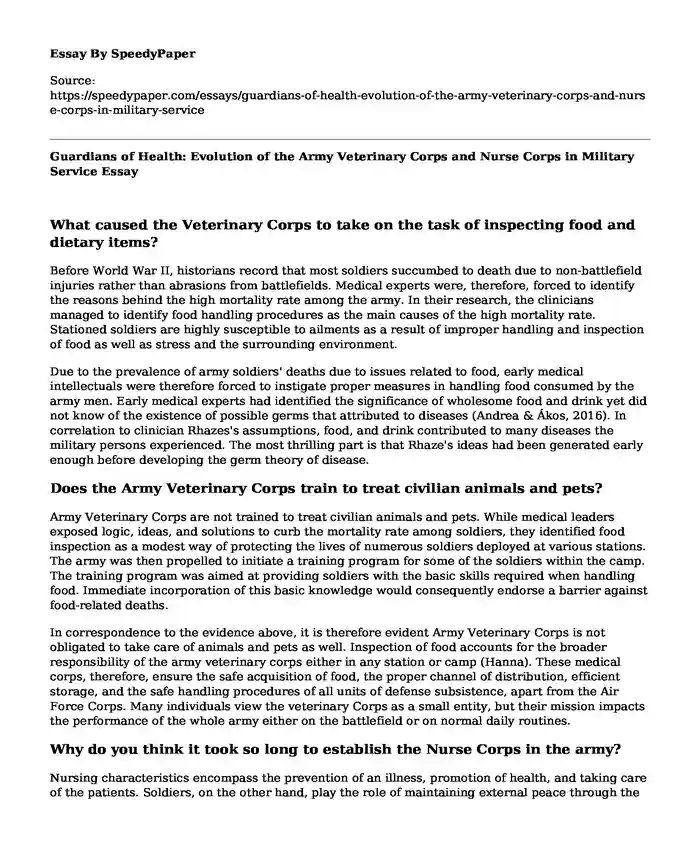
| Type of paper: | Essay |
| Categories: | Health and Social Care Nursing Army |
| Pages: | 3 |
| Wordcount: | 657 words |
What caused the Veterinary Corps to take on the task of inspecting food and dietary items?
Before World War II, historians record that most soldiers succumbed to death due to non-battlefield injuries rather than abrasions from battlefields. Medical experts were, therefore, forced to identify the reasons behind the high mortality rate among the army. In their research, the clinicians managed to identify food handling procedures as the main causes of the high mortality rate. Stationed soldiers are highly susceptible to ailments as a result of improper handling and inspection of food as well as stress and the surrounding environment.
Due to the prevalence of army soldiers' deaths due to issues related to food, early medical intellectuals were therefore forced to instigate proper measures in handling food consumed by the army men. Early medical experts had identified the significance of wholesome food and drink yet did not know of the existence of possible germs that attributed to diseases (Andrea & Ákos, 2016). In correlation to clinician Rhazes's assumptions, food, and drink contributed to many diseases the military persons experienced. The most thrilling part is that Rhaze's ideas had been generated early enough before developing the germ theory of disease.
Does the Army Veterinary Corps train to treat civilian animals and pets?
Army Veterinary Corps are not trained to treat civilian animals and pets. While medical leaders exposed logic, ideas, and solutions to curb the mortality rate among soldiers, they identified food inspection as a modest way of protecting the lives of numerous soldiers deployed at various stations. The army was then propelled to initiate a training program for some of the soldiers within the camp. The training program was aimed at providing soldiers with the basic skills required when handling food. Immediate incorporation of this basic knowledge would consequently endorse a barrier against food-related deaths.
In correspondence to the evidence above, it is therefore evident Army Veterinary Corps is not obligated to take care of animals and pets as well. Inspection of food accounts for the broader responsibility of the army veterinary corps either in any station or camp (Hanna). These medical corps, therefore, ensure the safe acquisition of food, the proper channel of distribution, efficient storage, and the safe handling procedures of all units of defense subsistence, apart from the Air Force Corps. Many individuals view the veterinary Corps as a small entity, but their mission impacts the performance of the whole army either on the battlefield or on normal daily routines.
Why do you think it took so long to establish the Nurse Corps in the army?
Nursing characteristics encompass the prevention of an illness, promotion of health, and taking care of the patients. Soldiers, on the other hand, play the role of maintaining external peace through the use of force. The difference in activities portrayed by nurses and soldiers posed significant challenges that initially delayed nurses' inclusion in the army.
Nursing became a well-recognized and appreciated profession by 1900, with the issuing of the American Journal of Nursing. For years nurses had consistently availed their esteemed service to the servicemen without engaging in active military training (Barr et al., 2019). sNurses success in the treatment of the Spanish-American war casualties largely contributed to their aggressiveness to be fully integrated into the Army and Navy consequently. Amid continuous demands from the nurses, an act concerning the inclusion of nurses in the army was released in 1899. Two years after the endorsement of the Act, the Army Nurse Corps was approved as part of the Army.
References
Andrea, G., & Ákos, J. (2016). A hidden corner of the "one health" concept: one health, the military veterinarian, and education. AARMS–Academic and Applied Research in Military Science, 15(2), 107-120.
Barr, S., Ferro, A., & Prion, S. (2019). An innovative academic-practice partnership to enhance the development and training of military nurses. Journal of Professional Nursing, 35(5), 369-378.
Hanna, S. E., Hanfelt, M. M., Cowart, J. R., & Evans, K. L. Army Veterinary Laboratory Service.
Cite this page
Guardians of Health: Evolution of the Army Veterinary Corps and Nurse Corps in Military Service. (2024, Jan 28). Retrieved from https://speedypaper.com/essays/guardians-of-health-evolution-of-the-army-veterinary-corps-and-nurse-corps-in-military-service
Request Removal
If you are the original author of this essay and no longer wish to have it published on the SpeedyPaper website, please click below to request its removal:
- Free Essay Describing the Bipolar Disorder Case Study
- Essay Sample on Implementation of an Action Plan
- Free Essay: The Most Important Piece From the Students' Experiences
- U.S. Healthcare System: Most Expensive and Unaffordable in the World - Essay Sample
- Essay Example: Leveraging Informatics in the Health Sector
- Essay Sample on Diagnostic Procedures Used in Psychiatric Disorders
- Free Paper Sample on Health Assessment
Popular categories




